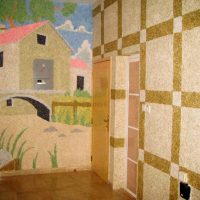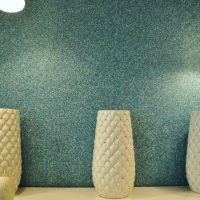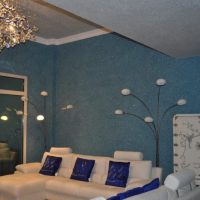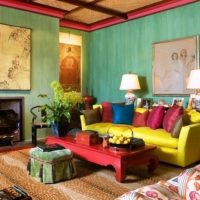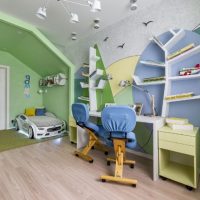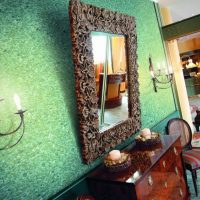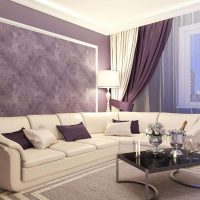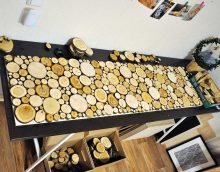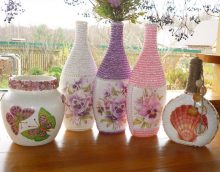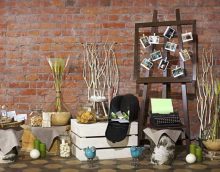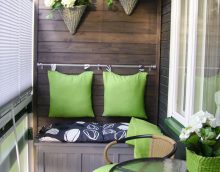Practical tips for using liquid wallpaper in the interior
Relatively recently, a new element has appeared on the building materials market - liquid wallpaper, also known as silk plaster. They have the appearance of a dry bulk material, which often includes cellulose, silk fibers, natural dyes, an adhesive component, plasticity components and decorative elements such as various sequins, mother of pearl and mica. They are sold in plastic bags. The main difference from plaster is the lack of sand and cement in the composition.

Liquid wallpaper sold dry

To create decorative effects, liquid fillers are added fillers - glitter, granules, etc.
Let us consider in more detail what types of material this is and how liquid can be used to transform a room.
Content
Varieties of liquid wallpaper
Liquid wallpapers are divided into 4 types:
- Cotton wallpaper. In their composition, up to 98% is occupied directly by cotton fibers. The remaining 2% are natural supplements. They have excellent sound insulation and thermal insulation, which makes it possible to use them in a children's room or bedroom.
- Silk wallpaper. They are a very attractive, wear-resistant and long-term material. Safe for health and non-toxic.
- Cellulose wallpaper. Due to the low cost of raw materials - they are the cheapest type of liquid wallpaper. As a disadvantage, this type is unstable to ultraviolet radiation. Therefore, the best option for use would be small rooms without bright sunlight, for example - a vestibule, an entrance hall or a corridor.
- Silk-cellulose mixture. Depending on the quantity in the composition of silk or cotton, prices vary slightly from "economy" to the middle segment.

Examples of textures of liquid wallpaper
Advantages and disadvantages
Liquid wallpaper, like all other finishing materials, has advantages and disadvantages. The positive qualities include the following:
- The material is eco-friendly.
- Due to the fact that the application technology eliminates the appearance of bumps and creases, it is ideal for use in rooms with a large number of corners, niches and recesses.
- During the application, they do not form joints and seams.
- Through the decoration of the walls with liquid wallpaper, you can even out small irregularities.
- Having various colors at your disposal, you can create a shade that will look perfect in your interior. The technology allows you to create all kinds of patterns and drawings.
- The range of compositions allows you to achieve a smooth, and embossed or rough surface.
- Application is possible on absolutely any surface - radiators, junction boxes, etc.
- Liquid wallpaper is a fireproof material. Therefore, they can be used in dachas and cottages with stove heating.
- And, perhaps, one of the main advantages is that liquid wallpaper can easily be corrected and restored in the event of a defect.

Liquid wallpaper suitable for interior decoration in any style

Liquid wallpaper does not absorb odors, does not fade and does not attract dust
With all the advantages, do not forget about the minuses:
- The main one is exposure to water. They are deformed by moisture, which makes it impossible to use them in bathrooms and in the working area of the kitchen.
- The cost of decorating the walls with liquid wallpaper is an order of magnitude higher than ordinary rolled ones.

Liquid wallpaper forms a slightly rough coating on the wall, warm to the touch
How to apply liquid wallpaper?
The first step is to prepare the wall surface for coating. Residues from previous materials should be completely removed. The base must be dry and clean. If the room is sufficiently damp, pre-treatment with an antiseptic solution is recommended.
Radical irregularities must be eliminated with putty and plaster. Then the walls are primed with a moisture-proof acrylic or colorless composition. It is not recommended to use colored soils, as they can be seen through under the topcoat.
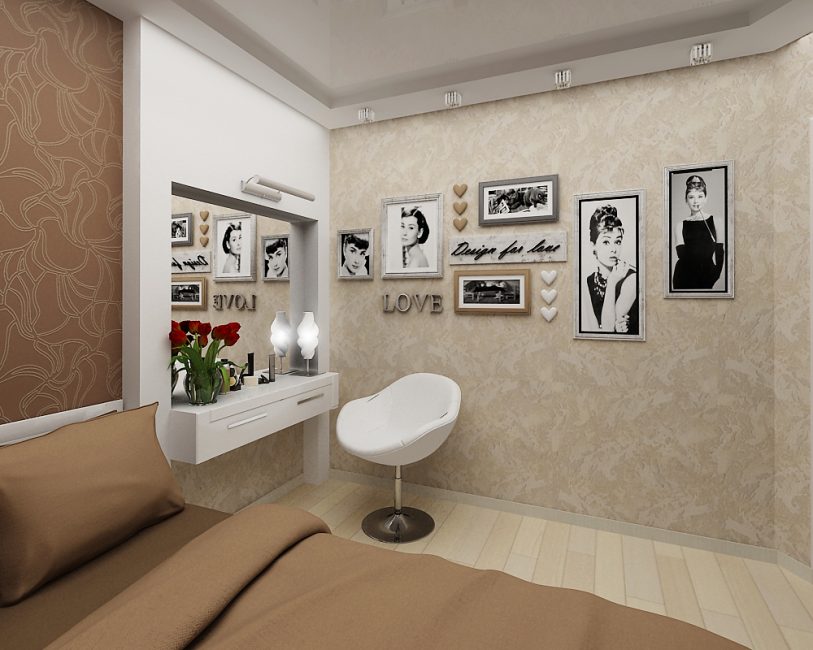
When applying a protective composition, the service life of paper wallpaper increases significantly
After completing the previous paragraphs, you can begin to apply liquid wallpaper.
You can apply them in various ways, such as "herringbone", "bouquet", "vertical" or "spiral". Choose the method that is most convenient for you.
Coating Sequence
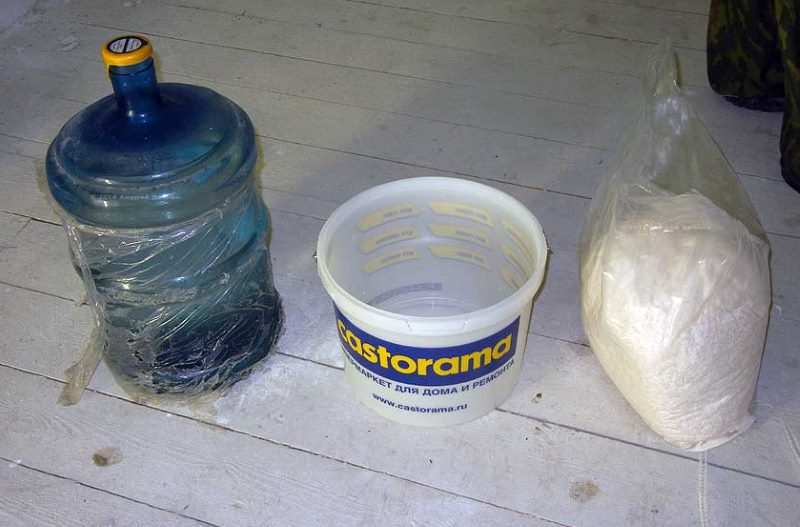
To prepare the working composition, you need clean water, a measuring bucket and the actual liquid wallpaper itself
- A dry mix of liquid wallpaper comes in bags. The contents must be poured into a plastic container and add 5 - 7 liters of water, the exact amount the manufacturer always indicates on the pack. One package is designed to cover a plot up to 4 square meters. m. It is forbidden to soak part of the package, otherwise, the components may not be distributed evenly and cast doubt on the final result.

Mix thoroughly so that no lumps remain.
- After adding water, it is necessary to thoroughly mix the resulting mixture to a homogeneous consistency and leave to soften for at least 8 hours. Immediately before starting work, one more stirring is required.

Before applying, mix the mixture, add water if necessary
- It is coated using a construction plastic grater. Recommended thickness is 1 - 2 mm. When working with corners - movements are made in the direction from it.

The material is distributed evenly over the wall surface.
- If after covering the room you still have a part of the mixture, save it and use it next time. Just add the leftovers to the new batch.

Work more conveniently with a transparent grater, especially when creating complex drawings
- Liquid wallpaper dries on average 2 days. At the same time, unlike ordinary rolled ones, they are not afraid of drafts. Therefore, boldly open the windows and ventilate the room.

It is better to cover the entire wall with wallpaper from one batch.
- In order to soften and remove a certain section of the wallpaper, just moisten it with a wet roller and carefully dismantle it with a spatula.

When joining a new and dried surface, the dried area should be slightly soaked
Working with the ceiling, the technology remains the same. After the final leveling of the plane, we apply a primer in 2 layers, observing an interval of about 4 hours so that each of them has time to dry. If your ceiling is plasterboard, most likely, smoothing with putty will not be required, and minor cracks in the seams will be filled with the wallpaper material itself.
Tip. If the room is sufficiently humid and damp - it is advisable to apply a moisture-proof colorless varnish on top of the liquid wallpaper. It will protect the coating from premature deformation.
Using liquid wallpaper you can create various patterns and reliefs. To do this, you can create a stencil, attach it to the wall. Then draw the background, the contours of the element and align the edges. After the final drying, remove the sketches. Then we fill the formed place with a different color or texture.

With the help of a stencil, you can creatively design a wall in a children's room
Using a little imagination, liquid wallpaper in the interior will achieve uniqueness and originality. Create various patterns and shapes. Monotone or colorful, smooth or embossed and textured. Thanks to this material it will turn out to realize all your fantasies.
How to make your own liquid wallpaper
Due to the high cost of this coating, there are some tips on how to make liquid wallpaper with your own hands and at home. The most common option is a material based on paper or sawdust.
If you decide to start manufacturing paper-based coatings, you first need to prepare a large amount of the main component. For these purposes, print media, sheets, magazines or other low-density paper can be used. It should be remembered that glossy pages will give a grayish tone to the finished material. Therefore, if the planned color is light enough, it is better to abandon their use. Depending on what kind of texture you plan to get, the paper is crushed either coarsely, then the relief will be more noticeable or small enough, which will allow you to achieve a uniform and smooth coating.

Cut the paper into strips and soak in water
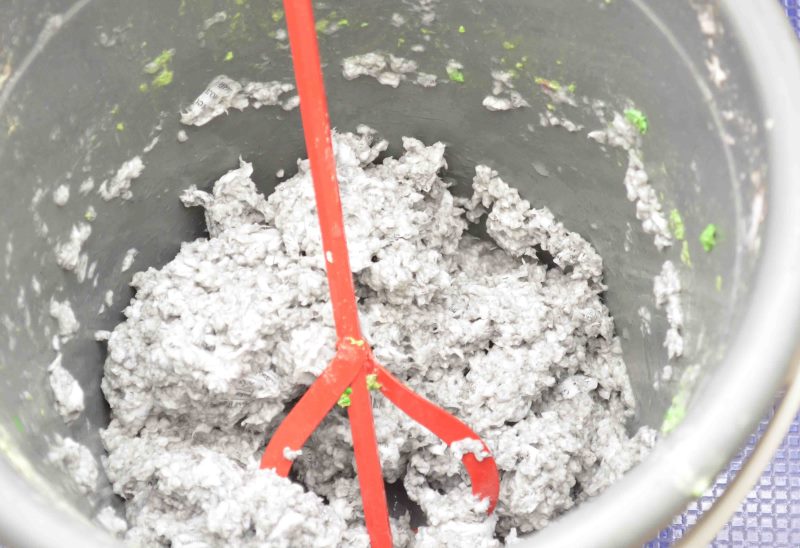
After about an hour, mix the paper with a construction mixer.
In addition to the paper component, you will need elements such as water, glue, gypsum (alabaster) and a water-soluble dye to color the material in the desired shade. With the help of sparkles, mica and mother of pearl, you can give the coating a zest and originality.
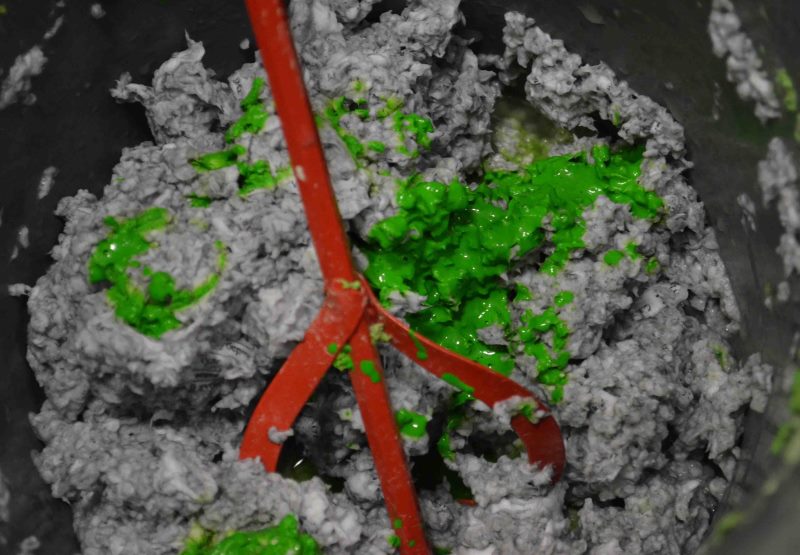
Add color and gypsum

Mix everything thoroughly again - the working mass is ready to be applied to the walls.
Directly for application, you will need a small set of tools, such as a spray bottle, gloves, a brush, plastic containers and a trowel (with the help of which ordinary wall-paper is glued).
For 1 kg of the paper component, 5 liters of water, 0.5 liters of glue, 0.5 kg of gypsum and antiseptic impurities will be required. This amount is enough to decorate a space of up to 5 square meters. m
The second budget option is sawdust as the main component of liquid wallpaper. The proportions of the preparation are exactly the same as in the previous version. To begin with, in a large capacity, soak the sawdust, then add glue and coloring pigments. Covering, leave the batch to brew for about 12 hours. At the last stage, add gypsum and knead thoroughly. After that, the mixture can be used.

The appearance of homemade liquid wallpaper a day after application is no different from the purchased material
Based on the foregoing, it can be argued that the manufacture of liquid wallpaper at home is a good alternative to purchased mixtures. This will help to save a significant part of the money, without reducing the number of possible textures and colors, since in construction stores you can find a wide range of the necessary dyes.
Liquid wallpaper in the interior
Liquid wallpaper in the interior looks quite unusual and attractive. They organically fit into any style of the room. With their help, you can transform the look of the living room, bedroom or children's room. The natural silk fibers included in the composition will add refinement and gloss to your apartment, creating the illusion that the walls are decorated with expensive textile wallpaper. At the same time, if there is a desire to update the design, wall decoration with new wallpaper will not be a hassle, since removing them is quite simple. It is enough to soak the surface with water.

Original Chess Drawing of Liquid Wallpaper

Spectacular accent wall highlight with red liquid wallpaper

Liquid wallpaper is often used to decorate living rooms and workrooms, wanting a practical and aesthetic interior.
Another useful feature of liquid wallpaper is the possibility of zoning the room. Playing with color and texture, you can visually expand the room and add light to it.Individual design can be developed for each room. For example, children's space can be stylized with boats, clouds, flowers and cute animals. And for the living room, a monotonous coating with the addition of a small amount of small sparkles or nacre will be appropriate. The so-called melange effect and a rather large coating texture will also look interesting and advantageous. If you want to depict various landscapes, contrasting transitions or bright color splashes - any design with liquid wallpaper is possible. But it should be remembered that this type of wallpaper is deformed in contact with water. Therefore, it is highly discouraged to use them in bathrooms and kitchens.
Having examined all the advantages and disadvantages of using liquid wallpaper in the interior, we can safely say that this is a great alternative to the familiar roll.
In the application process, they have a number of advantages, the main of which is the absence of seams, which are inevitably present with standard gluing. It is also worth noting that liquid wallpaper is more convenient to use. There is no need to measure every millimeter in order to avoid the appearance of gaps and crevices. The drying process is simpler, no need to fear drafts. You can use heaters, but you should periodically ventilate the room.

Bedroom decoration with liquid wallpaper in pastel colors

From liquid wallpaper you can create complex drawings and compositions on the walls
In conclusion, we add that liquid wallpaper in the interior can achieve high-quality, reliable and durable transformation of the room. With proper care and safety measures, such as preventing the ingress of water and excessive sunlight, they can last up to 20 years. A huge variety of colors and textures will allow you to carry out all your ideas and make the apartment rooms unique. Imagine, combine colors and shades in the interior, come up with a special design for yourself and your children - with such material as liquid wallpaper, all this becomes possible.
Video: Application of liquid wallpaper. Master Class.
